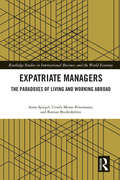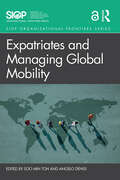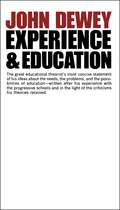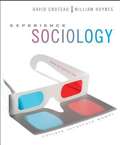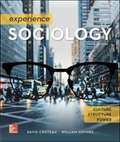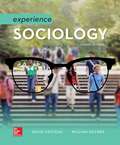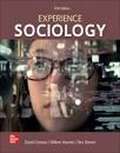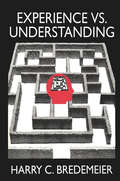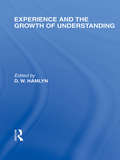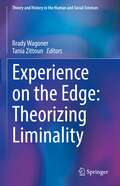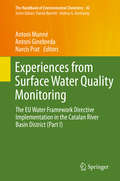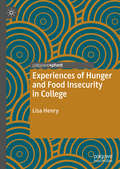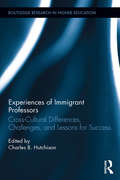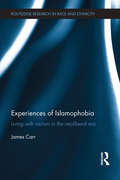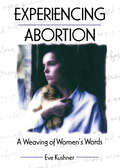- Table View
- List View
Expatriate Managers: The Paradoxes of Living and Working Abroad (Routledge Studies in International Business and the World Economy)
by Anna Spiegel Ursula Mense-Petermann Bastian BredenkötterSince the 1990s, economic and cultural globalization has propelled the transnational mobility of managers and fueled cross-border careers. Some scholars have argued for the emergence of a new global business elite with cosmopolitan mind-sets and homogeneous lifestyles, while others have highlighted their disconnection from the local surroundings and their everyday life within national expatriate ‘bubbles’. Thus, the question of whether today’s mobile professionals can be described as interculturally open and competent cosmopolitans, or as pronounced anti-cosmopolitans, is still unanswered. Expatriate Managers and the Paradoxes of Working and Living Abroad considers a core protagonist of economic globalization and the management of MNCs through the lens of a practice-based theoretical approach whilst seeking to address this question by building on intensive ethnographic case studies of expatriate managers, most of them high-ranking executives, from two comparative different home countries, the US and Germany. These managers, together with their families, have been assigned to China, Germany, or the US to perform demanding coordination tasks within their multinational corporations (MNCs). Based on detailed accounts of expatriate managers’ experiences and everyday practices, the book reveals the multiple and sometimes paradoxical ways in which they deal with cultural differences as they build up new forms of working, belonging and dwelling. The findings suggest that the newly emerging mind-sets and lifestyles of expatriate managers transcend the polarized images of mobile elites as either cosmopolitan ‘global managers’ or parochial anti-cosmopolitans. Expatriate Managers and the Paradoxes of Working and Living Abroad examines the global elite from an everyday perspective, showing that understanding the dynamics of a global economy requires probing into the lifeworld’s agency and everyday arrangements of the social actors who are putting globalization into practice.
Expatriates and Managing Global Mobility (SIOP Organizational Frontiers Series)
by Angelo DeNisi Soo Min TohMultinational enterprises continue to rely heavily upon expatriates as part of their global workforce. These expatriates, whose exact employment contract may take different forms, are assigned to help them develop global skills as well as to foster knowledge transfer. But managing this expatriate workforce is extremely complex, requiring a questioning of assumptions and sensitivity to new social and cultural dynamics. This book sets out to examine the problem of expatriate management through an I/O Psychology lens. Each chapter draws upon the expertise of scholars from around the world to provide insights into the latest research findings and remaining needs, pertaining to a wide variety of issues. The contributors of this book review the current state of the research of the issue at hand and then make recommendations for where the new frontiers of the research should be in the coming decades. This volume covers four sets of issues pertaining to expatriate management and global mobility in depth. First, the different decision points organizations must make about assigning someone to an overseas location for some period of time; second the different categories of employees in the multinational corporation and their unique characteristics and challenges; third, the various issues and implications of managing a globally mobile workforce; and fourth, the unique contexts of global mobility. Overarching future research themes are identified that lay out the research agenda for the coming decades. By bringing together key research, this book aims to help I/O psychologists understand, explore, and identify new ways of contributing to the understanding of the issues involved in managing an expatriate workforce. Incorporating state-of-the art I/O psychology research in this unique context bears the promise of yielding important new paradigms and practices.
Expatriates – Eine verhaltensökonomische Analyse von Erfolgsfaktoren (BestMasters)
by Karishma HerbertBedeutende Megatrends wie Globalisierung und Fachkräfteengpässe bewirken, dass multinationale Unternehmen mehr Führungs- und Fachkräfte ins Ausland senden oder diese selbst aus Eigenmotivation für mehrere Monate bis Jahre im Ausland arbeiten. Eine Auslandsentsendung bietet sowohl für die Unternehmen als auch die entsandten Mitarbeiter (Expatriates) neue Chancen und Potenziale. Doch was ist für einen Expatriate wichtig, um sich erfolgreich in einem Auslandseinsatz an die neuen Umstände sowie das neue Arbeitsumfeld anzupassen und gute berufliche Leistungen zu erzielen? Dieses Buch untersucht das Thema aus der verhaltensökonomischen Perspektive und beleuchtet, welche Verhaltensaspekte der Expatriates und ihrer Unternehmen zu einem erfolgreichen Einsatz beitragen. Karishma Herbert liefert zunächst einen Überblick zu den personalwirtschaftlichen Einflussfaktoren und zeigt auf, dass eine gute Organisation sowie ein Bewusstsein und Wissen über kulturelle Differenzen und Gemeinsamkeiten wichtig sind, jedoch dies allein keinen erfolgreichen Einsatz garantiert. Vielmehr spielt das tatsächliche Verhalten der Expatriates und weiterer Stakeholder eine entscheidende Rolle.
Expelling Public Schools: How Antiracist Politics Enable School Privatization in Newark
by John ArenaExploring the role of identitarian politics in the privatization of Newark&’s public school system In Expelling Public Schools, John Arena explores the more than two-decade struggle to privatize public schools in Newark, New Jersey—a conflict that is raging in cities across the country—from the vantage point of elites advancing the pro-privatization agenda and their grassroots challengers.Analyzing the unsuccessful effort of Cory Booker—Newark&’s leading pro-privatization activist and mayor—to generate popular support for the agenda, and Booker&’s rival and ultimate successor Ras Baraka&’s eventual galvanization of the charter movement, Arena argues that Baraka&’s black radical politics cloaked a revanchist agenda of privatization.Expelling Public Schools reveals the political rise of Booker and Baraka, their one-time rivalry and subsequent alliance, and what this particular case study illuminates about contemporary post–civil rights Black politics. Ultimately, Expelling Public Schools is a critique of Black urban regime politics and the way in which antiracist messaging obscures real class divisions, interests, and ideological diversity.
Expensive Basketball
by Shea SerranoOne of Barnes & Noble's Best Sports Books of 2025 From the #1 New York Times bestselling author of The Rap Year Book and Basketball (and Other Things), a clever and inventive examination of some of basketball's most iconic players, moments, games, and more, with original illustrations by Ian Klarer. Everything in basketball is measured. Everything in basketball is counted, and quantified, and computed. And yet, no matter how expansive the list of various pinpoint-specific statistical categories gets, some basketball things remain uncountable, and unquantifiable. Some moments are more poetry than calculation; more art than numerical value; more feeling than data processing. And thus: Expensive Basketball. From the final 196 seconds of Kobe Bryant&’s playing career to the Sue Bird backpedal, from the erosive terror of Tim Duncan to the Larry Bird memory carousel, Expensive Basketball is an affirmation of feelings.
Experience And Education: 1938-1939, Experience And Education, Freedom And Culture, Theory Of Valuation, And Essays (Collected Works Of John Dewey Ser. #13)
by John DeweyExperience and Education is the best concise statement on education ever published by John Dewey, the man acknowledged to be the pre-eminent educational theorist of the twentieth century. Written more than two decades after Democracy and Education (Dewey's most comprehensive statement of his position in educational philosophy), this book demonstrates how Dewey reformulated his ideas as a result of his intervening experience with the progressive schools and in the light of the criticisms his theories had received. Analyzing both "traditional" and "progressive" education, Dr. Dewey here insists that neither the old nor the new education is adequate and that each is miseducative because neither of them applies the principles of a carefully developed philosophy of experience. Many pages of this volume illustrate Dr. Dewey's ideas for a philosophy of experience and its relation to education. He particularly urges that all teachers and educators looking for a new movement in education should think in terms of the deeped and larger issues of education rather than in terms of some divisive "ism" about education, even such an "ism" as "progressivism." His philosophy, here expressed in its most essential, most readable form, predicates an American educational system that respects all sources of experience, on that offers a true learning situation that is both historical and social, both orderly and dynamic.
Experience Sociology
by David Croteau William HoynesExperience Sociology empowers students to use the lenses of Culture, Structure, Power to see sociology everywhere. Bringing theory and sociological concepts together, Experience Sociology helps students move beyond an individual perspective to gain a sociological perspective.
Experience Sociology
by David Croteau William HoynesExperience Sociology makes the familiar new. Using a unique, contemporary framework of culture-structure-power, students learn to apply sociological concepts through familiar lenses. Paired with a proven, personal, and adaptive learning experience, students move beyond memorization of topics to develop their sociological imagination. Connect is the only integrated learning system that empowers students by continuously adapting to deliver precisely what they need, when they need it, and how they need it, so that your class time is more engaging and effective.
Experience Sociology
by David Croteau William HoynesExperience Sociology has set the new standard for teaching Introductory Sociology. Approaching sociology through the key concepts of culture, structure, and power, the program enables students to see sociology everywhere, and make the familiar new. Presented in an accessible and engaging way that brings theory and sociological concepts together, students move beyond their individual perspective to gain a true sociological perspective. Connect, the proven online experience, adapts to the student’s learning needs, enhancing the understanding of topics and developing their sociological imagination.
Experience Sociology
by David Croteau William HoynesExperience Sociology has set the new standard for teaching Introductory Sociology. Approaching sociology through the key concepts of culture, structure, and power, the program enables students to see sociology everywhere, and make the familiar new. Presented in an accessible and engaging way that brings theory and sociological concepts together, students move beyond their individual perspective to gain a true sociological perspective. Connect, the proven online experience, adapts to the student’s learning needs, enhancing the understanding of topics and developing their sociological imagination.
Experience Sociology
by David Croteau William Hoynes Tara StammBy approaching sociology through the familiar concepts of culture, structure, and power, Experience Sociology engages students and enables them to see sociology in the world around them. Concepts are presented in an engaging and accessible way that brings theory and sociological concepts together, allowing students to move beyond their individual perspective to gain a true sociological perspective. The Fifth Edition of Experience Sociology reaches students in a time of an ongoing global health crisis, sustained economic uncertainty, a growing environmental calamity, and continued political and cultural upheaval. In working to understand a turbulent, ever-changing world, the timeless insights of sociology are more relevant than ever. When paired with McGraw Hill’s Connect, instructors can engage students in course content, enhancing the understanding of topics and developing their sociological imagination.
Experience Versus Understanding: Understanding Yourself in Twenty-First Century Societies
by Harry BredemeirBringing into play a lifetime of sociological analysis, Harry Bredemeier here explores fundamental issues in epistemology and ethics—and how social research has altered traditional views on such major subjects as the play of physical force in social life, the distinction between the physical and moral universe, risk taking and life making, rights and obligations—in short the most basic questions posed for our times by the sociological tradition.Bredemeier takes sharp issue with postmodern indictments of the Enlightenment movement of the early eighteenth century: that the Enlightenment was a cover for Western cultural imperialistic destruction of other cultures; that its glorification of reason undermined morality and paved the way for fascism and irrationality; or that it perpetuated a willful indifference to ecological concerns and to women's rights. The author clarifies all those issues and shows how reason, properly understood, transcends polemics that currently obfuscate appeals to experience.Experience vs. Understanding covers a wide range of topics. Among them are the need for interpretation of experiences; responsibility for consequences of one's choices; the danger in not thinking beyond immediate perceptions; all human activities are governed by cultural rules; individual virtues such as intelligence or courage are not sufficient to evaluate actions; and the issues of national foreign policy parallel those of each person's policy towards other people's. Experience vs. Understanding is a unique study that will be enjoyed by and beneficial to philosophers, sociologists, and political theorists, who are searching for the philosophical foundations of social science.
Experience and the growth of understanding (International Library of the Philosophy of Education Volume 11)
by D.W. HamlynThis volume examines some of the arguments that have been put forward over the years to explain the way in which understanding is acquired. The author looks firstly at the empricist thesis of genesis without structure, and secondly at the opposing theory, represented by Chomsky of structure without genesis. His greatest sympathy is with the theory of Piaget, who represents structure with genesis. He considers that Piaget's account is flawed, however, by its biological model and by its failure to deal adequately with the problem of objectivity. The second part of the book contains chapters on language, the differences between early and later learning, and on teaching. The book provides a general understanding of the principles that make it possible, and the differences between the ways in which they work at different stages.
Experience on the Edge: Theorizing Liminality (Theory and History in the Human and Social Sciences)
by Tania Zittoun Brady WagonerLiminality has become a key concept within the social sciences, with a growing number of publications devoted to it in recent years. The concept is needed to address those aspects of human experience and social life that fall outside of ordered structures. In contrast to the clearly defined roles and routines that define so much of industrial work and economic life, it highlights spaces of transition, indefiniteness, ambiguity, play and creativity. Thus, it is an indispensable concept and a necessary counterweight to the overemphasis on structural influences on human behavior. This book aims to use the concept of liminality to develop a culturally and experientially sensitive psychology. This is accomplished by first setting out an original theoretical framework focused on understanding the ‘liminal sources of cultural experience,’ and second an application of concept to a number of different domains, such as tourism, pilgrimage, aesthetics, children’s play, art therapy, and medical diagnosis. Finally, all these domains are then brought together in a concluding commentary chapter that puts them in relation to an overarching theoretical framework. This book will be useful for graduate students and researchers in cultural psychology, critical psychology, psychosocial psychology, developmental psychology, health psychology, anthropology and the social sciences, cultural studies among others.
Experience with Technology
by Ali Al-AzzawiWith a focus on gaining an empirically derived understanding of the underlying psychological dimensions and processes behind people's experiences with technology, this book contributes to the debate of user experience (UX) within several disciplines, including HCI, design and marketing. It analyses UX dynamics at various time scales, and explores the very nature of time and meaning in the context of UX. Experience with Technology uses personal construct theory (PCT) as a theoretical and methodological starting point to this project. Major case-studies are described that examine people's experiences with mobile media devices. The results show a group of super-ordinate constructs that, upon interaction, undergo a change in the way they vary and relate to each other, as well as the development of a high reliability UX-Scale. The book concludes by proposing the ICE (Interaction, Construction, and Evaluation) model of UX that consolidates its findings into a workable framework of UX. The proposed framework will be of particular use to designers and practitioners, and forms an empirically grounded starting point for further research.
Experience, Inc.: Why Companies That Uncover Purpose, Create Connection, and Celebrate Their People Will Triumph
by Jill PopelkaThe business leader’s guide to creating a winning employee experience In Experience, Inc.: Why Companies that Uncover Purpose, Create Connection, and Celebrate Their People Will Triumph, veteran business leader and growth strategist Jill Popelka delivers a hands-on guide to building a flexible, adaptable, and engaged workforce that can enable your organization to evolve with emerging challenges. You’ll find the insights you need to build a company culture that prioritizes your people, resulting in an empowered and future-ready workforce. Filled with stories from the author’s extensive experience as the President of SAP SuccessFactors, the book also offers: Advice from global thought leaders on some of today’s most pressing issues Practical resources for any employee to improve their productivity and impact Tips on creating a culture that works for the organization and its peopleExperience, Inc. is an essential tool for business leaders of all levels, from the C-suite and senior executives to people managers and human resources practitioners. It is a must-read for organizations looking for ways to build a sustainable, productive, and exciting workplace centered around the most critical driver of business success: employees.
Experiences and Explanations of ADHD: An Ethnography of Adults Living with a Diagnosis (Cultural Dynamics of Social Representation)
by Mikka NielsenExperiences and Explanations of ADHD: An Ethnography of Adults Living with a Diagnosis presents research on the lived experiences of those diagnosed with attention deficit hyperactivity disorder (ADHD). Drawing on in-depth interviews with adults diagnosed with ADHD, the book provides an examination of how the diagnosis is understood, used, and acted upon by the people receiving the diagnosis. The book delves into the phenomenology of ADHD and uncovers the experiences of a highly debated diagnosis from a first-person perspective. It further considers these experiences within the context of our time and culture and contributes to a discussion of how to understand human diversity and deviance in contemporary society. Studying both societal conditions behind the emergence of ADHD, questions concerning everyday life with ADHD, and interpretations of the diagnosis, the book offers an analysis of the intertwinement of experiences of suffering and diagnostic categories. This book will appeal to academics, researchers, and postgraduate students in the fields of cultural psychology and medical anthropology, as well as those with an interest in the sociology of diagnoses.
Experiences from Surface Water Quality Monitoring
by Antoni Ginebreda Antoni Munné Narcís PratThis book details theexperiences gained by the Catalan Water Agency (ACA) in a Mediterraneanwatershed - the Catalan River Basin District - following the launch of the EUWater Framework Directive (WFD) in the year 2000. Experts in rivers,reservoirs, lakes, wetlands and estuaries present 13 chapters defining toolsfor water-status assessment specially adapted to Mediterranean conditions. Thecontent of this and the companion volume Experiencesfrom Ground, Coastal and Transitional Water Quality Monitoring: The EU WaterFramework Directive Implementation in the Catalan River Basin District (PartII) are the result of an excellent collaboration between the ACA andseveral Catalan universities and research centers to cope with new challengesprovided by the WFD monitoring requirements. The volume serves as a usefulguide for environmental managers and scientists engaged in other European aswell as Non-European river basins.
Experiences of Health Risks: Prevention, Power Dynamics and Inequalities (Critical Studies in Risk and Uncertainty)
by Claudine Burton-JeangrosThis book focuses on health risks, a domain in which risk expansion has been particularly prolific. As a result of massive gains in scientific knowledge, made possible by statistical developments, data accumulation and computerisation over the last decades, more and more attention has been geared towards risks in the fields of public health and medicine. Specifically directed towards concrete experiences of health risks, the book analyses the social contexts in which these experiences occur to understand how people, in their diverse positions, actually think, feel, act, and interact around experiences of risk. The author argues that recurrent debates about risk exist because most of the time the notion leaves aside the complexity of social processes surrounding actual experiences and interpretations of vulnerability and danger in society. This book will be of interest to students and scholars of sociology of health and medicine and risk studies, as well as health professionals and policy-makers facing the complexity of acting and deciding in the risk society.
Experiences of Hunger and Food Insecurity in College
by Lisa HenryThis volume explores the experience of hunger and food insecurity among college students at a large, public university in north Texas. Ninety-two clients of the campus food pantry volunteered to share their experiences through qualitative interviews, allowing the author to develop seven profiles of food insecurity, while at once exploring the impact of childhood food insecurity and various coping strategies. Students highlighted the issues of stigma and shame; the unwillingness to discuss food insecurity with their peers; the physical consequences of hunger and poor nutrition; the associations between mental health and nutrition; the academic sacrifices and motivations to finish their degree in the light of food insecurity; and the potential for raising awareness on campus through university engagement. Henry concludes the book with a discussion of solutions—existing solutions to alleviate food insecurity, student-led suggestions for additional resources, solutions in place at other universities that serve as potential models for similar campuses—and efforts to change federal policy.
Experiences of Immigrant Professors: Challenges, Cross-Cultural Differences, and Lessons for Success (Routledge Research in Higher Education)
by Charles B. HutchisonEducational institutions all over the world continue to attract the services of foreign-born scholars. In addition to the culture shock that immigrants experience in unfamiliar countries, these scholars often undergo "pedagogical shock." Through autobiographical accounts of foreign-born professors from Africa, Asia, Europe, and the US, this volume examines the experiences of foreign-born professors around the world to provide insight on the curricular, school-systemic, and sociological differences and challenges that are encountered, and how to help resolve them. It will help administrators, institutions, and immigration and comparative education scholars understand the cross-cultural challenges and coping strategies that define the private and professional lives of foreign-born professors across the globe.
Experiences of Islamophobia: Living with Racism in the Neoliberal Era (Routledge Research in Race and Ethnicity)
by James CarrSince 9/11 interest in Islamophobia has steadily increased – as has the number of academic publications discussing the phenomenon. However, theoretical expositions have dominated the field. Lived experiences of Islamophobia, by contrast, have received little attention. In recognition of the importance of addressing this imbalance, this book provides theoretically-informed analyses alongside everyday testimonies of anti-Muslim racism, set comparatively in an international context. Carr argues that the failure of the neoliberal state to collect data on anti-Muslim racism highlights the perpetuation of ‘race’ blindness within governance. Not only does this mean that the salience of racism is denied in the lives of those who experience it, but this also enables the state to absolve itself from challenging the issue and providing the necessary supports to Muslim communities. Offering original empirical research and theoretical engagement with the concept of ‘race’-blind neoliberal governance, this book will appeal to students and scholars across the social sciences, in addition to policymakers and activists working in this topical area.
Experiences of Sexual Minority and Gender Diverse Individuals in Romantic Relationships: Heeding a Global Call (Advances in Personal Relationships)
by Ashley K. Randall Pamela J. LannuttiThe lived experiences of sexual minority and gender diverse (SMGD) people in romantic relationships remain relatively understudied compared to their heterosexual and cisgender counterparts. Existing research has predominantly focused on cisgender gay or lesbian individuals, particularly those who identify as White, resulting in significant gaps in our understanding of diverse SMGD experiences. This volume pioneers an effort to address this gap by uniting interdisciplinary researchers to examine key aspects of SMGD individuals' lives and relationships across 12 countries. Specifically, this book focuses on the individual well-being, relational well-being, social support, and dyadic coping of SMGD people. The book's insightful findings are invaluable to researchers, practitioners, policymakers, and anyone striving for a more equitable global society.
Experiences of War and Nationality in Denmark and Norway, 1807–1815
by Rasmus Glenthøj Morten Nordhagen OttosenThis book explores the impact of the Napoleonic wars on Danish-Norwegian society and accounts for war experiences and the transformation of identities among the popular classes and educated élites alike.
Experiencing Abortion: A Weaving of Women's Words
by Eve KushnerIf you&’ve had an abortion and are feeling isolated and vulnerable, Experiencing Abortion will remind you that you are not alone and that you must feel your emotions in order to accept your choice and heal. Each woman responds to abortion in her own way, yet, as this sensitive, insightful book shows, there are many similarities among women&’s post-abortion emotions. Sharing in the firsthand, personal experiences of other women who speak for themselves in this book will help you come to terms with anguish, stress, grief, anger, or any other overwhelming emotions you might be feeling. Don&’t go on ignoring or blocking out your feelings. Learn to incorporate your experience into your sense of self in a healthy way.By reading Experiencing Abortion, you will learn about the multiple feelings and reactions abortion can trigger, the process of accepting an abortion, and the struggle to control fertility without treating your body as an enemy. Offering you a safe, honest, and supportive environment in which to explore your feelings about your abortion, this book discusses many important topics, including: the way moods can overtake you after abortion how avoiding your experience can defer acceptance, which in turn leads to denial and guilt how pregnancy, abortion, and subsequent bleeding can affect your perception of your body the struggle to enjoy sex after your abortion your heightened awareness of gender after an abortion how your intimate relationships may change after an abortion the psychological reasons you may sometimes forgo birth control accepting yourself after a second abortionExperiencing Abortion will help women who have had an abortion understand that it is a complex physical and emotional experience that doesn&’t necessarily end after a week or a month or a year. It will also help professionals in abortion facilities and therapists who offer pre- and post-abortion counseling understand how abortion affects each individual differently and how they might help women work through their feelings both before and after abortion. Partners, friends, and families will find this book helpful and informative as they try to help their loved one get through this sometimes difficult, even traumatic, experience.
